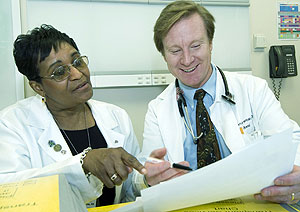Daniel Brennan, M.D., already had his foot solidly in the door when he interviewed for a job at the School of Medicine 13 years ago. Administrators from the school had, after all, recruited him to come to town for an interview.
So he arguably would have received the job even if he hadn’t helped revive a VIP later that same day at the Department of Surgery’s Christmas party.

“The wife of the former chairman of surgery collapsed, and I basically helped resuscitate her,” recalls Brennan, a professor of medicine. “My first reaction was to think that impressed the doctor who was then the head of surgery.
“I later started to wonder if that was all in my mind, but then I heard one of the surgeons telling this story at a surgery conference, so I knew it had given me some real notoriety.”
Brennan, who was 33 at the time, came to the University in 1993 as head and sole member of a new section, transplant nephrology. With his expert guidance, the kidney transplant program at Barnes-Jewish Hospital doubled the number of transplants it performed, jumping from 59 the previous year to 120 in Brennan’s first year.
“That’s pretty much where we’ve been since then — somewhere between 100 and our high, which was 150,” he says.
“What we’re really proud of, though, is the fact that in the years since 1996 we’ve consistently driven acute kidney rejection rates down to less than 5 percent. That rate used to be in the 50 percent range.”
Brennan, 46, is still the section’s only full-time faculty member, but he now sees patients with two kidney specialists he trained — Brent Miller, M.D., associate professor of medicine, and Matt Koch, M.D., assistant professor of medicine — and a third nephrologist, Marcos Rothstein, M.D., professor of medicine.
“Dan is an unselfish and natural leader and a creative and compassionate physician, and it’s no accident that he’s built a world-class transplant nephrology section at Washington University essentially from scratch,” says Marc R. Hammerman, M.D., the Chromalloy Professor of Renal Diseases.
For Brennan, helping patients is the central focus and biggest reward of his work.
“I’ll be having a bad day and feeling sorry for myself, and then I’ll get to the clinic and think to myself, ‘You know what? I don’t have kidney disease, and I never did,'” he says. “All my patients have kidney disease, and I want to help them.”
Brennan enjoys getting to know the patients and their families and the positive nature of the transplant process when it works well.
“They tried to recruit me into industry last year, and I turned them down because even though they were going to let me see patients, they wouldn’t be patients in my clinic,” he says.
Born in Wisconsin and raised in suburban Chicago, Brennan likes to say what’s on his mind but doesn’t seem inclined to do so in an abrasive or self-centered way.
For example, he’s humble enough to freely admit that he first became interested in his undergraduate college, Cornell College in Mount Vernon, Iowa, largely on the basis of mistaken identity. He thought it was the Ivy League Cornell University.
“I asked my dad, ‘Dad, where’s Cornell?’ and he said, ‘Ithaca, New York,’ and I said, ‘Not Mount Vernon, Iowa?'”
Brennan’s laughter when he recalls this incident rings with gratitude: The mistake worked out well for him.
His mother, an immunologist, had previously had positive experiences with Cornell College student interns, and he was impressed by the campus and the opportunities it offered when he visited, so he decided to pass on the Ivy League experience for an Iowa university.
Seated in his office in a special chair that he uses because of a back injury, Brennan, who’s wearing a Beatles tie given to him by one of his daughters, remembers his years in Iowa with great fondness.
He met his wife, Susan, then a philosophy student, at Cornell. They married after he finished his third year as a medical student at the University of Iowa.

When a discussion with a mentor helped fix Brennan’s interest in the area of transplant nephrology, the mentor recommended he go to Brigham and Women’s Hospital in Boston. Four years later, Brennan transferred to a post in transplant nephrology at the University of Omaha and Bishop Clarkson Hospital in Omaha, Neb., his wife’s hometown.
At WUSTL, Brennan has established a reputation both as a dedicated and energetic clinician and an innovative researcher.
With the help of frequent collaborator Greg Storch, M.D., the Ruth L. Siteman Professor of Pediatrics and professor of molecular microbiology and of medicine, Brennan has conducted pioneering research into the threats viruses pose to kidney transplant recipients.
“Dan manages to integrate his interests in patients and clinical research very effectively,” Storch says. “He’s very enthusiastic and committed, and that makes him fun to work with.”
Brennan praises Storch as “the best mentor I’ve ever had.”
He is particularly excited about their research into the BK virus (so named for the initials of the first patient diagnosed with it).
The virus is widespread in the general population; by the time they’re teenagers, 90 percent test positive for it.
The virus normally doesn’t cause any problems, but when the immune system is suppressed — as in patients who’ve just received a kidney transplant — it can become a harmful infection.
Brennan estimates the virus infects the new kidney in less than 5 percent to 10 percent of kidney transplant patients, but notes that 50 percent of those patients will lose their new kidney to the infection and the remainder will be left with a kidney that is only marginally functional.
Brennan and his colleagues showed that taking patients off immune suppression drugs when the BK virus began showing up in their blood could prevent the virus from getting into the kidney.
|
Daniel Brennan Position: Professor of medicine; head and sole full-time faculty member of transplant nephrology Hobbies: Biking, swimming, playing guitar and enjoying St. Louis with his family Years at the University: 13 Family: Wife, Susan; children Katie, Chris, Meaghan and Maddy |
“In transplantation, you want to be like Goldilocks — just the right amount of immune suppression, not too much and not too little,” he says. “If there’s too much, the patients can get infections and cancers; too little, and they reject the new kidney.”
Brennan says BK has been “almost like a gift from the transplant gods” because testing for the viruses’ reactivation in the bloodstream lets clinicians clearly know when they’ve given their patients too much immune suppression.
Another major branch of Brennan’s research involves the systems used to allocate organs for transplantation.
In these studies, he collaborates with former student Mark Schnitzler, who has a doctorate in economics and is now director of Saint Louis University’s Center for Outcomes Research.
In a recent paper, Brennan and Schnitzler’s analysis suggested that an effort to increase the number of kidneys available to African-American patients was misguided.
“The system organizers recently eliminated the points given to potential patient-organ matches on the basis of immune compatibility factors that frequently differ slightly between white and African-American patients,” Brennan says.
“We showed that this created a lose-lose situation because African-American patients frequently do better on dialysis than on transplantation, while the reverse is true in white patients.”
Brennan and Schnitzler argued that a better way to increase organs allocated to African-American patients would be to try to increase what are known as conversion rates among families of potential African-American organ donors.
The term refers to the percentage of families who sign the final agreement to release a donor’s organs into the transplant system.
“We argued that all that we need to eliminate the disparity in organ availability is to increase the conversion rate among African-American families by 10 percent,” he says. “We don’t even need more donors to eliminate the racial disparity.”
When not dealing with the intricacies of organ transplants and allocation, Brennan spends his spare time biking, swimming, playing guitar and enjoying St. Louis with his family.
Brennan jokingly notes that he and his wife, Susan, have added a child in every state they’ve lived in. Katie, the eldest at 18, was born in Iowa; Chris, 15, in Boston; Meaghan, 13, in Omaha; and Maddy, 11, in Missouri.
He praises St. Louis for its accessibility.
“St. Louis is a city that can be used,” he says. “It’s livable — you can go down to The Hill for dinner, you can go see the Arch or a museum in Forest Park, or you can go to professional sporting events.”